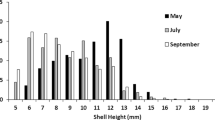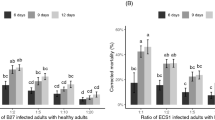Abstract
Three species of Entomophthorales were found on adult carrot flies (Psila rosae F.) during two successive seasons:Entomophthora muscae (C.) Fres.,Condiobolus apiculatus (Thax.) Remaud. & Keller andErynia sp.E. muscae was by far the most common species and caused epizootics in one carrot fly population up to 3 times per year. Flies cuaght in the hedge showed a higher infection level than flies caught in the field close to the hedge. Flies caught 200 m away from the hedge showed the lowest infection level. Apparently the hedge was the site of infection, since carrot flies, killed byE. muscae, were found there attached to the underside of the leaves. Flies caught on yellow sticky traps developed only to a limited extend symptoms and gave little information about the fungus infection levels.
Résumé
Trois espèces d'Entomophthorales ont été trouvées sur des Mouches de la Carotte adultes durant 2 saisons successives:Entomophthora muscae (C.) Fres,Conidiobolus apiculatus (Thax.) Remaud. & Keller etErynia sp.E. muscae était de loin l'espèce la plus commune causant des épizooties dans une population de mouche de la carotte plus de 3 fois par an. Les mouches capturées dans la haie manifestaient un niveau d'infection plus élevé que celles capturées dans le champ à proximité de la haie. Les mouches capturées à 200 mètres de la haie manifestaient le niveau d'infection le plus bas. Apparemment, la haie était le foyer d'infection car les mouches de la carotte tuées parE. muscae s'y trouvaient attachées à la face inférieure des feuilles. Les mouches capturées sur les pièges jaunes développaient uniquement des symptômes limités et donnaient peu d'information sur les niveaux d'infection dus au champignon.
Similar content being viewed by others
References
Burn, A. J. — 1984. Life table for the carrot flyPsila rosae. —J. Appl. Ecol., 21, 891–902.
Cohn, F. — 1855.Empusa muscae und die Krankheit der Stubenfliegen. Ein Beitrag zur Lehre von den durch parasitische Pilze characterisierten Epidemieen. —Nov. Actorum Acad. Caes. Leop.-Carol. German. Nat. Cur., 25, 299–360.
Eilenberg, J. — 1983.Entomophthora-svampe på gulerodsfluen [Psila rosae F.] Muligheder for anvendelse afEntomophthora-svampe til biologisk bekæmpelse af skadedyr. —Tidsskr. Planteavl, 87, 399–406.
Eilenberg, J. — 1987. Abnormal egg-laying behaviour of female carrot flies [Psila rosae F.] induced by the fungusEntomophthora muscae. — Ent. Exp. Appl. (in press).
Eilenberg, J. — 1988. The culture ofEntomophthora muscae (C.) Fres. in carrot flies [Psila rosae F.] and the effect of temperature on the pathology of the fungus. —Entomophaga (in press).
Esbjerg, P., Jørgensen, J., Nielsen, J. K., Philipsen, H., Zethner, O. &Øgaard, L. — 1983. Integreret bekæmpelse af skadedyr med gulerodder, gulerødsfluen [Psila rosae F.,Dipt.: Psilidae] og ageruglen [Agrotis segetum Schiff.,Lep.: Noctuidae] som afgrøde-skadedyr model. —Tidsskr. Planteavl, 87, 303–355.
Freuler, J., Fischer, S. &Bertichoz, P. — 1982. La mouche de la carotte,Psila rosae Fab. [Diptera: Psilidae]. III. Avertissement et seuil de tolérance. —Rev. Suisse Viticult. Arboricult. Horticult., 14, 275–279.
Getzin, L. W. — 1982. Seasonal activity and geographical distribution of the carrot rust fly [Diptera: Psilidae] in Western Washington. —J. Econ. Entomol., 75, 1029–1033.
Keller, S. — 1984.Entomophthora muscae als Artencomplex. —Mitt. Schweiz. Entomol. Ges., 57, 131–132.
Philipsen, H. — 1983. Brug af gule limplader til vurdering af risiko for angreb af gulerodsfluen [Psila rosae F.]. —Tidsskr. Planteavl, 87, 389–397.
Sant, L. van't — 1963. Lewenswijze en Bestrijding van de Wortelvlieg [Psila rosae F.] in Nederland. —Vers. Landbouw. Onderz., 67, 1–131.
Städler, E. — 1975. Täglicher Aktivitetsrhytmus der Eiablage bei der Möhrenfliege,Psila rosae Fabr. [Dipt.: Psilidae]. —Mitt. Schweiz. Entomol. Ges., 48, 133–139.
Stevenson, A. B. — 1976. A disposable adhesive trap for monitoring the carrot rust fly. —Proc. Entomol. Soc. Ontario, 107, 65–69.
Wakerley, S. B. — 1964. The sensory behaviour of carrot fly [Psila rosae Fab.,Dipt.: Psilidae]. —Entomol. Exp. Appl., 7, 167–178.
Waterhouse, G. M. &Brady, B. L. 1982. Key to the species ofEntomophthora sensu lato. —Bull. Br. Mycol. Soc., 16, 113–143.
Wheatley, G. A. — 1971. Entomology. —Ann. Rep. Nat. Veg. Res. Stat. Wellesbourne, 1970, 21, 92–105.
Wilding, N. &Lauckner, F. B. — 1974.Entomophthora infecting wheat bulb fly at Rothamsted, Hertfordshire, 1967–1971. —Ann. Appl. Biol., 76, 161–170.
Author information
Authors and Affiliations
Rights and permissions
About this article
Cite this article
Eilenberg, J., Philipsen, H. The occurrence of Entomophthorales on the carrot fly [Psila rosae F.] in the field during two successive seasons. Entomophaga 33, 135–144 (1988). https://doi.org/10.1007/BF02372648
Received:
Accepted:
Issue Date:
DOI: https://doi.org/10.1007/BF02372648
Key-Words
- Entomophthora muscae
- Conidiobolus apiculatus
- Erynia sp.
- Psila rosae
- mortality factor
- population regulation




